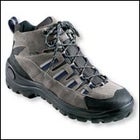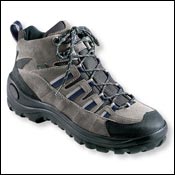My advice is: Be concerned about foot care. You really donÂ’t want to come down with a bad case of blisters, given your medical history.
L.L. Bean GTX Mountain Treads Mid-Cut
 GTX Mountain Treads Mid-Cut
GTX Mountain Treads Mid-CutSo IÂ’d prepare carefully, particularly regarding your footwear. You donÂ’t say exactly what the trip entails. Will you be backpacking? Doing long hikes in a single day, such as a down and up? Or part of a guided trip? Some slight variations in ideal footwear might be in order depending on the trip, but in general I think you need a midweight hiking boot that offers good support and foot protection (from thorns and rocks), along with good comfort.
You have lots of choices here. One excellent new boot that combines support with running-shoe comfort is MontrailÂ’s Stratos XCR Hiking Boot ($140; www.montrail.com). ItÂ’s a mid-height boot that doesnÂ’t come up quite as high as a “regular” hiking boot, but it will still cover your ankle bone. ItÂ’s very light (just over a pound), with a well-padded EVA midsole. I can take or leave the Gore-Tex liner, but on a spring trip you might be doing some stream-hopping, so it could be useful. A similar boot is L.L. BeanÂ’s well-priced GTX Mountain Treads Mid-Cut ($119; www.llbean.com), with a mid-height design, waterproof liner, and midsole built like those found on trail-runners. Provided you have a good fit, either the Stratos or GTX Mountain Treads offer near out-of-the-box wearability.
If you want something with a little more heft, then consider ScarpaÂ’s mostly leather ZG 40 GTX ($159; www.scarpa.com). IÂ’ve always like Scarpa boots, and these offer the protection of a full-height boot with a lot of weight (nearly three pounds). They also have a Gore-Tex liner, which may not be ideal for a hot-weather hike, but theyÂ’re breathable, and you may appreciate the waterproof protection if conditions are sloppy.
Finally, for a classic all-leather boot, take a look at GarmontÂ’s Dakota ($249; www.garmont.com). Its one-piece leather construction is inherently water-resistant, while offering plenty of support and durability. This is the boot if youÂ’re planning on carrying a load over multiple days. Just take the time to break them in with local, short hikes. Then work your way up.
Whatever you decide, make sure you fit them carefully. Wear good socks—a wicking liner made with CoolMax or polypropylene is advisable as well as an oversock, such as the SmartWool Light Hiker ($12; www.smartwool.com). And take some time to wear them on several warm-up trips to ensure you aren’t developing hot spots.
And train carefully for the trip. The Grand Canyon is an odd duck; you start out with the EASY part, the downhill. Many is the hiker who has happily switchbacked down into the deep, only to look up after an hour, legs slightly rubbery from the downhill pounding, and said, “Oh, darn!” Or something else that shouldnÂ’t be repeated here. Combine that with the Grand CanyonÂ’s elevation (the canyon rim on the south side is around 8,000 feet), its potential for heat, and its aridity, and youÂ’ve got a challenging hike. But the scenery! Ah, sublime.
Read GORP.comÂ’s for more info on healthy peds.
Also, check out this yearÂ’s more than 400 must-have gear items, including , in the 2006 BuyerÂ’s Guide.


